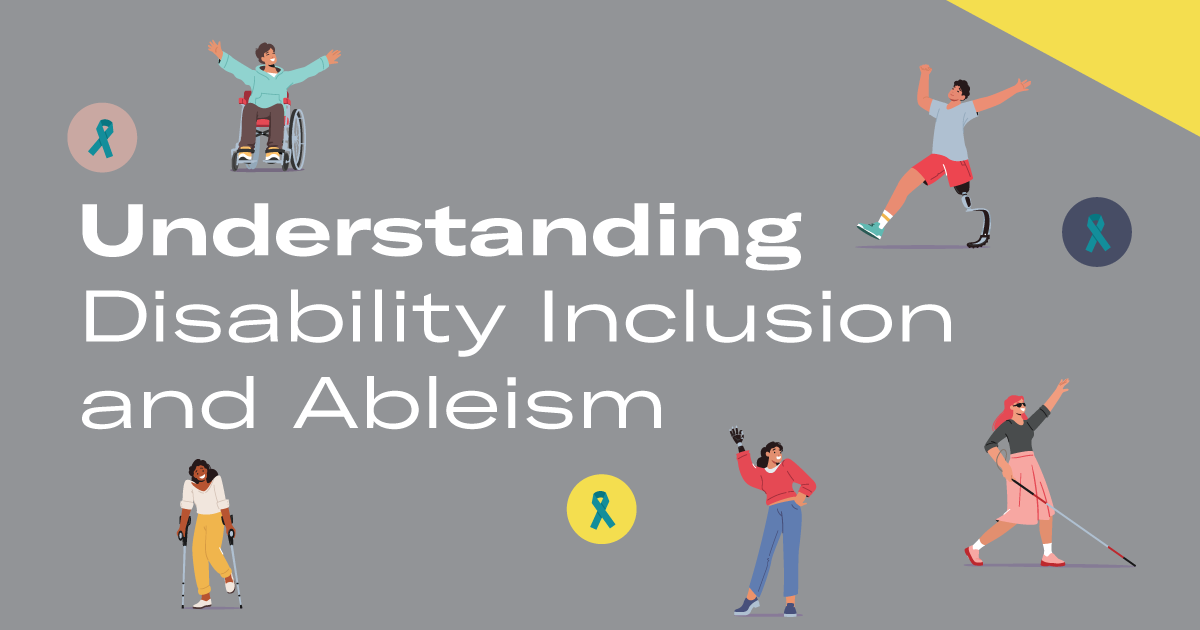[Resource] Understanding Disability Inclusion and Ableism

Click HERE to learn more
According to the CDC, “Disability inclusion means understanding the relationship between the way people function and how they participate in society, and making sure everybody has the same opportunities to participate in every aspect of life to the best of their abilities and desires.” People with disabilities are integral parts of our world and community, yet they often face inaccessible or unwelcoming spaces online. The word disability itself is a limiting term, as it refers to an immense spectrum of experiences. Disabilities can affect a person’s auditory, cognitive, neurological, linguistic, visual, emotional or physical abilities moving through the world, both online and offline.
According to Ashley Eisenmenger in Ableism 101, “ableism is the discrimination of and social prejudice against people with disabilities based on the belief that typical abilities are superior” or that the average person is without a disability by default. Ableism is the underlying force which creates assumptions that a person by default is non-disabled. Ableism can also contribute to the oversight of not considering whether online spaces are accessible. This is why a stronger awareness of web access (or lack thereof) must be part of our collective consciousness. According to Manish Dudharejia, in 9 Ways to Make Your Website More Accessible, “Web accessibility applies to all disabilities that affect access to the web,” meaning that we need to include much more than just measures for visually or hearing impaired users as we move towards full inclusivity in online spaces. Accessibility measures like alternative text or “alt text” (which provides a description of images) or captioning during video meetings (to provide readable text in real time) have started to become more commonplace, but this is in no way an end point.
A Disability-Informed Future
Recent reliance on online spaces for school, work, leisure, and social life have highlighted the glaring lack of accessibility which many people face in digital spaces. Although it’s commonly thought that individuals with disabilities are a minority, within the next five years, 20% of the population will identify as having a disability. This translates to over 55 million people — a large portion of the population. Approximately three-quarters of Americans with disabilities report using the internet on a daily basis, all while navigating barriers due to unmindful programing or oversight. At the same time, individuals with disabilities are less likely to own or have access to digital devices. A 2022 research report “people without disabilities were likelier to be aware of, utilize, and perceive the usefulness of digital services during the COVID-19 pandemic including application, information, delivery, and subscription services.” As such, the exclusion of people with disabilities in online spaces only furthers existing inequalities.
Specifically, inaccessibility in online spaces contributes to the already disproportionate rates of unemployment, educational attainment, the lack of supplemental social support, and more. The COVID-19 pandemic has only worsened inequalities not only in regards to health risk, but in regards to access to resources, community, information, and jobs. Elderly populations were significantly over impacted by the intersections between COVID-19 and disability access. According to the UN, “More than 46 per cent of older persons – those aged 60 years and over—have disabilities and more than 250 million older people experience moderate to severe disability.” This raises the issue not only of access to digital devices and online spaces, but barriers in familiarity using them.
The multitude of factors and intersections within experiences with disability must be consulted as we move towards more inclusive spaces online. A disability-informed future requires more awareness, education, and standardized implementation of accessible technologies.
-
By
JL Heinze | NSVRC
-
Published
May 23, 2024
-
Subject Area
- Age-friendly Communities
-
Audience
- Service Providers (Non-profits, Community Organizations, Local government)
-
Category
- Advocacy
Newsletter
Sign up for the Healthy Aging CORE Alberta e-news to keep up-to-date with activity from the platform and the Community-Based Seniors Services (CBSS) sector across the province.
